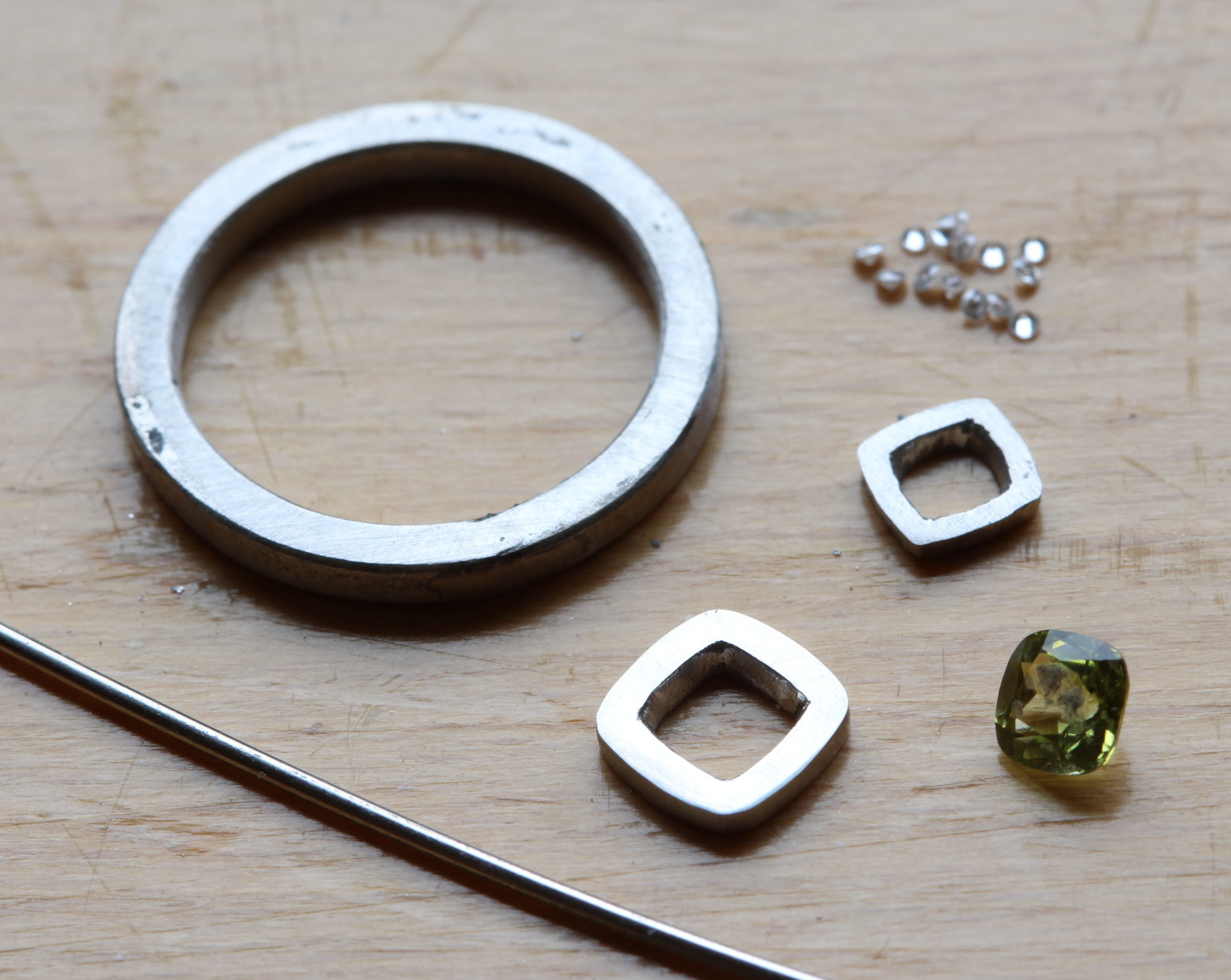
Unusual Engagement Rings: Pallasite Comission
This is one of the most exciting bespoke commissions we have worked on at Jacqueline & Edward, a unique engagement ring handmade in ethically sourced recycled platinum and featuring an extraterrestrial pallasite peridot, an extremely rare gemstone sourced from the Jepara meteorite.
These gemstones formed in pallasite meteorites when planet-sized objects collided with one another during the first 5-20 million years of the solar system’s history, fragmenting and ultimately ending up within the asteroid belt as we know today.
By definition, unique engagement rings testify to the unequalled covenant shared between two people, and a bespoke commission gives our customers the opportunity to weave their personal stories, histories and ideas into their deeply significant piece of forever-jewellery and what will become a future family heirloom.
Yet when Jacqueline & Edward were approached by a customer with the proposition of handmaking a platinum engagement ring featuring an extraterrestrial pallasite peridot gemstone, this really expanded our understanding of what a unique engagement ring could be and the stories it could tell.
Our co-founder Mark was thrilled to build a commission as unique as this. ‘I love geology, I always have. The chance to work with the Jepara Pallasite, one which Phil supplied and went to painstaking lengths to acquire, was akin to an early Christmas present. The only difference…. I had to give the present back at the end of the festive season.’
Creating an unusual engagement ring

Having never worked before with extraterrestrial pallasite peridot, this presented our extremely talented and highly experienced head of workshop Cat with some interesting challenges. “These gemstones are relatively soft on the Mohs scale of hardness, so great care had to be taken when working with them.”
Hand making a ring as delicate and complex as this bespoke commission was no easy task. As with every Jacqueline & Edward piece, the platinum band was hand forged the old, traditional way with manual tools and using only ethically sourced recycled metals. Eleven individually crafted pieces, each handmade to exact sub-millimetre measurements, were soldered together to create the band and double bezel gallery setting. An elegant, tapered shank leads to a diamond halo surround – centering a 0.49ct cushion-cut extraterrestrial pallasite peridot, its striking olive and lime tones striated with vibrant needle-like inclusions.

Rare gemstone makes for an unusual engagement ring
Within an already rare gemstone, these rainbow coloured needle motifs appear in less than 5% of the pallasite found in the Jepara meteorite; it’s thought perhaps they are signatures of the unfathomable shocks and forces the meteorite underwent during its early formation four-and-a-half billion years ago, one billion years before life on Earth.
The probability of one of these gemstones making its way to our planet is astronomically low, and as our customer Phil discovered, the journey of verifying and grading the stone’s provenance was almost equal in cosmic ambition. Had the Jepara meteorite had a slightly different trajectory, even by a fraction of a degree, it would have been forever lost at sea – yet even in the safe hands of humanity, it almost succumbed to the competing bureaucracies of Earth’s gemology institutions.
Luckily this pallasite peridot’s 4,500 million year journey was not in vain, and through working together with Jacqueline & Edward, Phil’s partner is now the custodian of a unique engagement ring suitable in its complexity, elegance and ambition to honour such a rare gem. Embellishing his proposal, Phil, within an eloquently written note given alongside the engagement ring explained in detail just how unlikely this mineral was to have found its way into his possession before finishing with words which will be remembered in Jacqueline and Edward for time to come ‘The 0.49ct gemstone in your ring, is perhaps the second rarest Gem in the world. You, of course, are the rarest.”
Get in touch if you would like to create your own bespoke engagement ring or browse our collection of ethical engagement rings for inspiration
About pallasites
We find pallasites fascinating, so if you wanted to learn a little more detail, do read on:
Pallasite is a form of olivine, crystals of green peridot gemstone formed on asteroids that have collided with Earth. As a general term, Pallasite also refers to the class of these iron-rich asteroids, named after the 18th century German naturalist Peter Pallas who first studied these interplanetary objects, wandering outer space for billions of years before their paths made the extremely unlikely and fortuitous interaction with our Earth’s orbit.

Meteoritic material has been used to make jewellery for as long as humans have been smithing metal. This confirms what we already know about the deep cultural, religious and ceremonial significance of meteors, recorded in myths and annals alike for hundreds of years before the relatively recent scientific interests of the last three centuries.
Peter Pallas was one of the earliest Europeans to become interested in fallen meteoritic rock. In his 1778 text Journey through various provinces of the Russian Empire, he describes one of his first discoveries, a meteorite shown to him by a Cossack miner and a blacksmith local to present day Krasnoyarsk:
…the whole internal character of it is a malleable, brittle, white, lacy iron, holey like a coarse sea sponge, whose interstices are quite filled with round and oblong drops of a very brittle but hard amber-yellow, completely clear and pure glass…
Pallas did not yet know that these meteorites were extraterrestrial, and history had not yet honoured some of these brittle, oblong olivine and peridot gemstones with Pallas’ name. One of his contemporaries, the physicist Ernst Chladini, was ridiculed for his assertions that these rocks were from outer space.
It wasn’t until in an unusual event in the Yorkshire village of Wold Newton in 1795 that the international scientific community began to take Pallas and Chladini’s claims seriously. At around 3 o’clock on the 17th December, local ploughman John Shipley watched a fireball streak the sky and impact the ground a few yards from where he stood. Within days the British chemist Edward Howard and French mineralogist Jacques de Bournon studied the impact and debris and concluded the rock must have come from outside of Earth. The Wold Cottage Meteorite can still be viewed at the Natural History Museum in London.
This was the beginning of the science of meteoritics as we know it today. Over two centuries later, another strange and fortuitous coincidence has brought meteoritic material to Yorkshire and close to the birthplace of modern meteoritics. This time a customer approached Jacqueline & Edward with an extremely rare gemstone, a green Pallasite peridot with a confirmed origin within the Jepara meteorite which landed on the Javanese coast in 2008.

